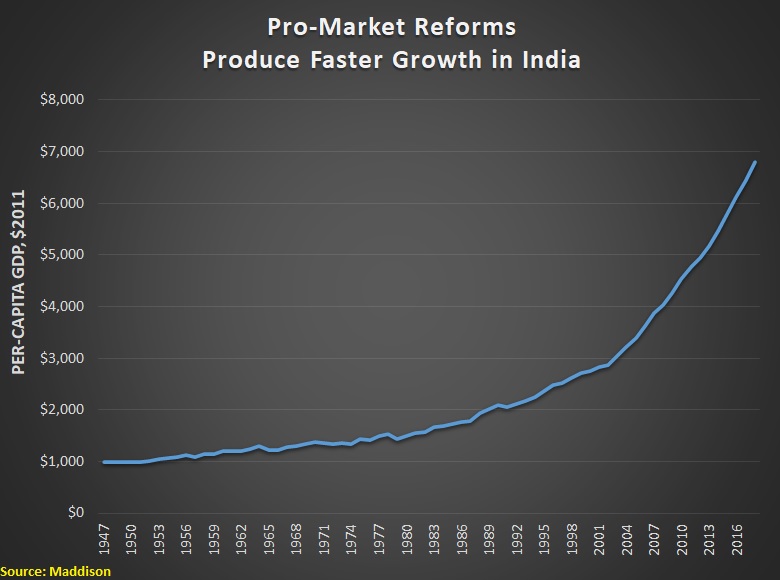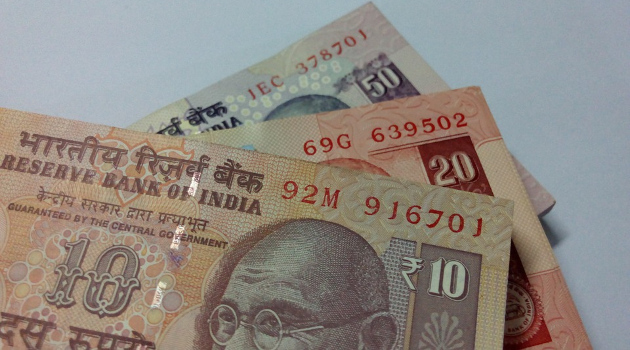I only share long videos when they satisfy key criteria, such as being very informative and very educational.
This video from Arthur Brooks is both.
What I like most is that he does a very good job of showing that concern for the disadvantaged is the most important reason to support free markets and limited government.
And he does this by exploring some very interesting and challenging topics, such as Denmark’s unusual mix of free markets and a welfare state (I’ve referred to that country’s public policy as a combination of Dr. Jekyll and Mr. Hyde).
But I want to focus on his discussion of India’s partial economic liberalization. We’ll start by perusing the most-recent edition of Economic Freedom of the World to confirm that there was a significant increase in economic liberty during the 1990s.

But it’s also important to stress that India’s partial economic liberalization was…well, partial.
India is currently ranked #108 for economic freedom, which is mediocre at best, and it does especially poorly in areas such as regulation and trade.
The good news is that the country’s policies are not as bad as Venezuela’s. The bad news, though, is that it’s also nowhere close to being as good as Singapore.
If you want to understand economic policy in India, you should read this study by Swaminathan S. Anklesaria Aiyar.
He starts by explaining the awful policies that existed prior to 1991.
India was in such poor shape before 1991 that it takes an effort to recall how bad things were. …India’s slow-growing, inward-looking socialism made it unimportant in global terms, save as an aid recipient. …India’s poverty ratio did not improve at all between independence in 1947 and 1983; it remained a bit under 60 percent. …In 1991, it took two years for anyone to get a telephone landline connection. N. R. Narayana Murthy, head of top software company Infosys, recalls that in the 1980s, it took him three years to get permission to import a computer and over one year to get a telephone connection. …In 1991 Indian politicians and industrialists feared that economic liberalization would mean the collapse of Indian industry… Before 1991 very high tax rates (up to a 58 percent corporate tax) plus a high wealth tax meant that businesses kept income off the books.
There was a decent amount of economic liberalization in the 1990s.
After 1991 direct tax rates gradually came down substantially (to 30 percent plus surcharges for individuals and corporations). The wealth tax on shares was abolished, making it possible to raise shareholder value without being penalized for it. …The corporate tax was cut from a maximum of 58 percent to 30 percent, yet corporate tax collections increased from 1 percent of GDP to almost 6 percent at one point. …Personal income tax rates also fell from 50 percent to 30 percent, but once again collections rose, from 1 percent of GDP to almost 2 percent. …economic liberalization has facilitated the rise to the top of a vast array of new entrepreneurs. …In the two decades since 1991, India’s literacy rate has shot up by a record 21.8 percentage points, to 74 percent…much faster in the era of reform than in the earlier era of socialism. …Life expectancy in India is up from an average of 58.6 years in 1986-91 to 68.5 years. Infant mortality is down from 87 deaths per 1,000 births to 40.
This partial liberalization has produced good results, as illustrated by Table 2.
India’s growth rate has improved, which is why various social indicators (poverty, literacy, mortality) have improved.

But India should not be considered a role model.
There is still far too much government.
How can we sum up 25 years of economic reform? Three major trends are visible. First, the vast majority of successes have been private‐sector successes, whereas the vast majority of failures have been government failures, mainly in service delivery. Second, wherever markets have become competitive and globalized, the outcomes have been excellent. …In the 1990s, the government gradually opened up the economy, abolishing industrial and import licensing, freeing foreign exchange regulations, gradually reducing import tariffs and direct tax rates, reforming capital and financial markets, and generally cutting red tape. Those changes enabled India to boom and become a potential economic superpower. But some areas were never liberalized, such as land and natural resources, and those areas have been marked by massive scams.
I’ll close by sharing this chart, which is based on the Maddison database.
As you can see, per-capita economic output climbed faster after a few pro-market reforms were implemented.

After giving some speeches in India back in 2018, here’s how I summarized my conflicted assessment.
Indians are enormously successful when they emigrate to the United States. And they also do very well when they migrate to Singapore, South Africa, and other places around the world. Yet Indians in India remain comparatively poor. …There’s a saying in the country that “India grows at night, while government sleeps.” …In other words, policy is generally not friendly, but the private sector manages to find “breathing room” to operate in spite of government. So poverty is falling, slowly but surely.
It would be great if poverty could fall much faster, but the current government doesn’t seem to have any interest in the policies that would make that happen.
———
Image credit: itkannan4u | Pixabay License.


